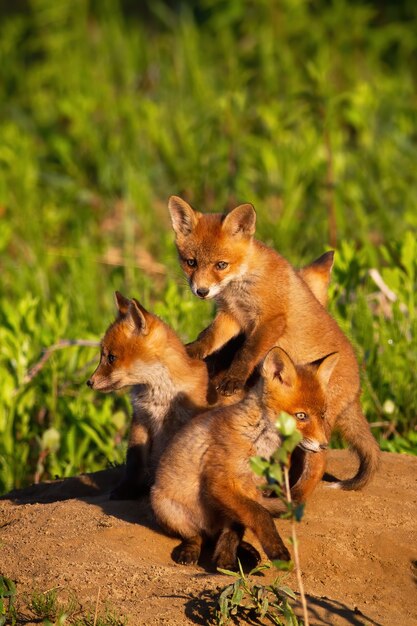

Red foxes are known for their beautiful red fur coat.
Red foxes have excellent adaptability and can be found in a variety of habitats around the world.
Red foxes are highly intelligent animals, known for their problem-solving skills.
The scientific name for red foxes is Vulpes vulpes.
Red foxes are the largest species of foxes and typically weigh between 7-15 pounds.
Red foxes have a diverse diet that includes small mammals, birds, and even fruits and vegetables.
Red foxes are opportunistic hunters, often stealing food from other predators.
Red foxes are known for their ability to communicate using a wide range of vocalizations, including barks, screams, and howls.
Red foxes are solitary animals, although they may form small family units during the breeding season.
Red foxes are excellent swimmers and can easily navigate through water.
Red foxes have acute hearing, which helps them locate prey even in densely vegetated areas.
Red foxes have a keen sense of smell and can detect food from long distances.
Red foxes are primarily nocturnal, often hunting and exploring during the night.
Red foxes have a natural curiosity and are known to investigate objects and scents in their environment.
Red foxes have a specialized adaptation called the Jacobson’s organ, which allows them to detect scents more effectively.
Red foxes are excellent diggers and often create dens underground for shelter and raising their young.
Red foxes are known for their playful behavior, engaging in activities such as wrestling and chasing their tails.
Red foxes are highly territorial animals and will mark their territory using scent markings.
Red foxes have a gestation period of approximately 52 days, after which they give birth to a litter of 4-6 pups.
Red foxes have a diverse range of coat colors, including variations of red, brown, silver, and black.
Red foxes are known for their ability to adapt to urban environments, often taking advantage of human food sources.
Red foxes are excellent climbers and can scale trees and fences with ease.
Red foxes have a lifespan of up to 10 years in the wild, although some have been known to live longer in captivity.
Red foxes play an important role in controlling populations of small mammals, helping to maintain ecosystem balance.
Red foxes have been featured prominently in folklore and mythology, often representing cunning and intelligence.
Red foxes have retractable claws, which help them climb trees and grasp onto prey.
Red foxes have a specialized adaptation called the tapetum lucidum, which enhances their night vision.
Red foxes are known for their ability to run at high speeds, reaching up to 30 miles per hour.
Red foxes have a diverse range of vocalizations, including screams that can sound similar to a human’s scream.
Red foxes have a well-developed sense of hearing, which helps them locate prey underground, such as rodents.
Red foxes have a cunning hunting technique called mousing, where they listen for the sounds of mice under the snow and then pounce to catch them.
Red foxes have a bushy tail that helps provide balance while running and can also be used for communication and signaling.
Red foxes mate for life and often stay with their mate throughout the year.
Red foxes are known for their ability to store excess food by burying it in shallow holes or hiding it in dense vegetation for later consumption.
Red foxes have a flexible spine that allows them to contort their bodies and maneuver through narrow spaces.
Red foxes have a keen sense of direction and can find their way home even after being transported long distances.
Red foxes are highly adaptable to different climates, from the cold Arctic tundra to the hot deserts.
Red foxes have a distinctive musky odor that helps them mark their territory and communicate with other foxes.
Red foxes have a specialized adaptation called the nictitating membrane, which protects their eyes while hunting in tall grass or dense foliage.
Red foxes have a strong homing instinct and will often return to their birthplace to establish their own territory.
Red foxes have denser fur during the winter, which helps insulate them from the cold temperatures and allows them to survive in harsh conditions.
Red foxes have a wide range of vocalizations, including a unique gekker call used during interactions with their young.
Red foxes have excellent camouflage that blends in with various environments, allowing them to hide from predators and ambush prey.
Red foxes have a complex social hierarchy, with dominant individuals having priority access to resources and mates.
Red foxes often engage in scent marking, with males urinating on objects or in specific areas to communicate their presence to other foxes.
Around the world, coffee enthusiasts enjoy Monin coffee concentrate since it is a multipurpose product. Conveniently combining…
The Importance of Choosing the Right Shower for Your Bathroom Renovating your bathroom can be…
Usain Bolt holds the record for the fastest 100-meter sprint in history.Bolt was named Sportsman…
Love is in the air... and it smells suspiciously like chocolate!Roses are red, violets are…
Life's a beach, take a picture and relax.Sun, sand, and salty kisses. That's what beach…
Hungary is home to the largest thermal water cave system in the world.The Rubik's Cube…